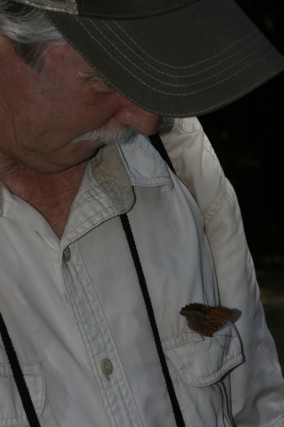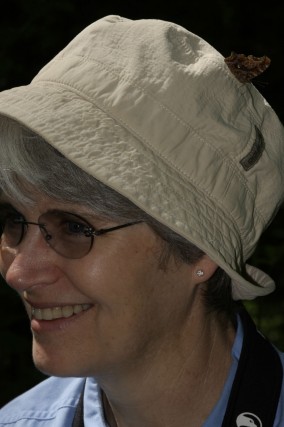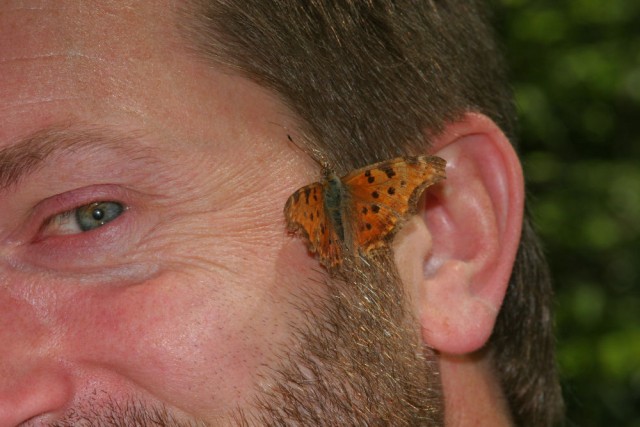NEAR NASHVILLE
The best areas to look for butterflies are along the Jim Bailey Trail, around the Visitor’s Center, Spillway Trail (goes to Lake Woodhaven Spillway) and Creech Hollow Lake. All three trails are rated Easy/Moderate. There is a wet meadow near Creech Hollow Lake that is usually very productive especially in the fall when 8-10 skipper species in one day is not unusual. Powerline mows can also be good areas. Springtime has had the most butterfly species recorded so far with 24 observed in a 4 hour period.
Cheatham Wildlife Management Area
This WMA is 20,000 acres of upland property managed mostly for deer by the Tennessee Wildlife Resources Agency. Drive the dirt and gravel roads where allowed. This area is largely unexplored, but should yield good results in the future for butterfliers. It is open year round.
The Wills Perennial Garden is the sunniest and the most butterfly-friendly of the garden areas at Cheekwood. The Burr Terrace Garden, Herb Garden and Howe Wildflower Garden may also be good areas depending on what is blooming. Check out the areas around Botanic Hall and Visitor Center too. There is also a restaurant and art museum.
Couchville Glade is a good spot to see Southern Dogface, Sleepy Orange, Gray and Red-banded Hairstreaks and Crossline Skippers in the fall. Look for Northern Broken-Dash here in late summer. May-July is the bloom period for the Tennessee Coneflower (Echinacea tennesseensis), the first species from Tennessee to qualify as a federally endangered species. Butterflies will nectar on this plant, as well as on other cedar glade endemics. These are well worth the photographs as you get both butterfly and rare plant.
For the whole park area, summer averages about 15 butterfly species for 3-4 hours of looking. Goatweed Leafwing eggs, caterpillars and chrysalides may be seen around the Visitor’s Center garden on woolly croton in August. ‘Olive’ Juniper Hairstreaks are most abundant in late April – June.
This is actually a series of parks connected by roads.
The Narrows of the Harpeth has been a longtime favorite for the Middle Tennessee Chapter for our first field trip of the spring, usually in late March or April. Falcate Orangetips abound, and other spring species include Zebra Swallowtail, Henry’s Elfin, ‘Olive’ Juniper Hairstreak, Eastern Tiger Swallowtail and Pearl Crescent. Walk the roadsides for Falcates and into the woods for the Zebras and the Tigers (also streamside). The others are usually seen at the summit where the view of the valley below and the Harpeth River is admirable.
Hidden Lake State Natural Area is a good place to see butterflies particularly in late spring and summer. Stands of common milkweed in the open fields act as magnets for nectaring. Pipevine and Giant Swallowtails, Zabulon Skipper, Great Spangled Fritillary, Banded Hairstreak, Lace-winged Roadside-Skipper, Tawny Emperor, Northern Pearly-eye, Gemmed and Carolina Satyr are found there.
Natchez Trace National Historic Parkway
This is a two-lane scenic roadway which approximates the route of the original Natchez Trace. This northern end of the Trace near Nashville has a variety of habitats and topographic changes from the Central Basin with an average elevation of 600-750 feet, to the Western Highland Rim where there are extensive areas higher than 1,000 feet. Both the Central Basin and the Western Highland Rim are characterized by rolling terrain and numerous streams. Both areas are known for their wildflower arrays.
Whatever the season, there is scenic beauty and wildlife to be found. Mid-March brings the first spring wildflowers, which brighten the woodland trails, as the Falcate Orangetips and Spring Azures appear. Zebra Swallowtails nectar on Jacob’s ladder (Polemonium reptans) beside the trail at Burn’s Branch, and black locust trees (Robinia pseudoacacia) drip with white fragrant blossoms along the parkway.
Summer brings heat, humidity and a fever of butterflies mating, laying eggs and nectaring. The butterfly season extends into late October and early November, when dogwood (Cornus florida), red maple (Acer rubrum), sumac (Rhus spp.), sweetgum (Liquidambar styraciflua), and swamp chestnut oak (Quercus michauxii)) paint the landscape with scarlet, and Monarchs, Gulf Fritillaries and Cloudless Sulphurs abound. Hickory (Carya spp.), river birch (Betula nigra), redbud (Cercis canadensis), beech (Fagus grandifolia), American elm (Ulmus americana) and tulip poplar (Liriodendron tulipifera) trees try to outshine the red leaves with their yellow ones. These sites can be enjoyed on foot or by auto, although you get a better “feel†for the Trace and see more butterflies, if you go on foot.
MORE THAN ONE HOUR AWAY
Land Between The Lakes consists of 170,000 acres between Kentucky Lake and Lake Barkley. It is a huge multi-use area and is managed by the USDA Forest Service. There are so many places to look for butterflies and many have not yet been explored or documented.
Drive the “Trace” road [not the Natchez Trace, this is another Trace] in late September and you will probably be treated to Leonard’s Skipper, Monarchs and Southern Dogface nectaring on the blazing star (Liatris spp.). Check out the lake areas, old roads and pull-offs along the main road. There are visitor’s centers on the north and south end of the Trace; a nature station; elk & bison prairie; 1850s Homeplace and a planetarium. There are numerous campgrounds and lake access areas, hunting areas and programs are available for children/families most of the year.
Standing Stone State Rustic Park
May Prairie State Natural Area
For a detailed list of areas in the Tennessee Valley, check out the NABA Tennessee Valley Chapter’s suggestions.




